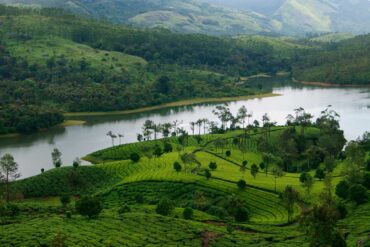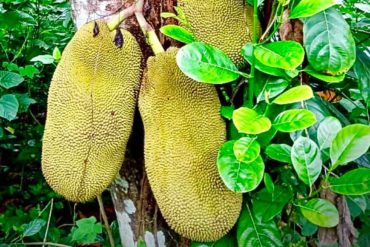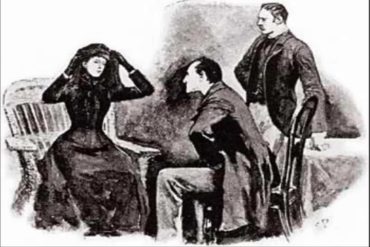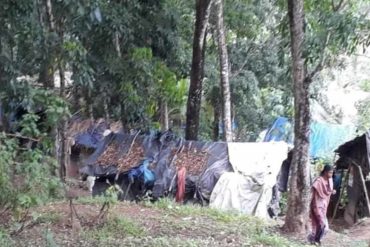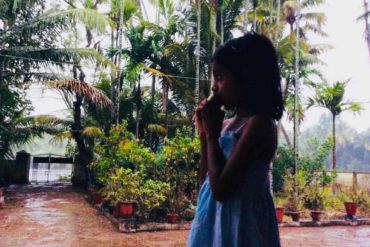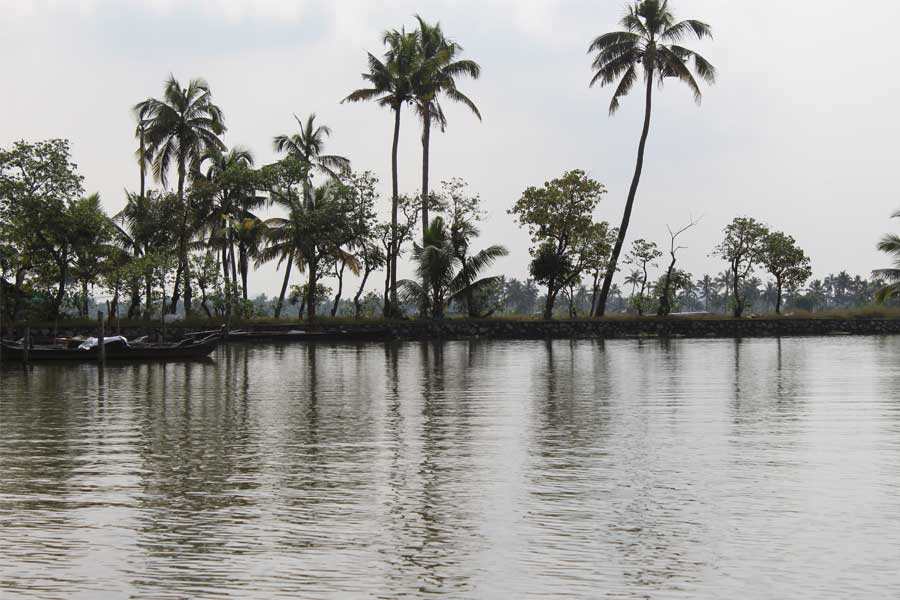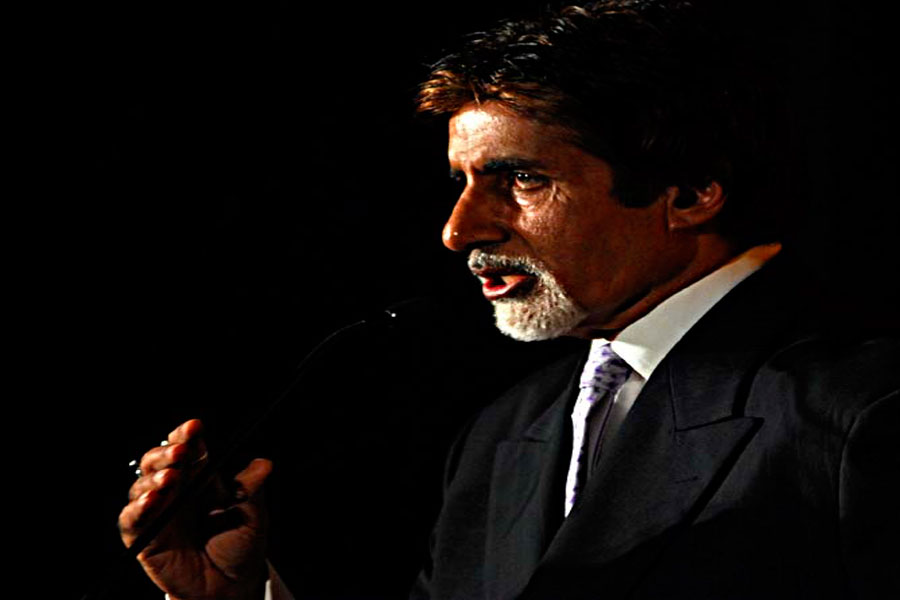It is said that we travel in search of people whom we overlook in our neighbourhood. So when my wife Sabeena Ismail and our six-year-old daughter Charu Gulnar and I decided to go on a one-day trip on our bike, we chose the neighbouring islets of Kochi—the island cluster of Pizhala, Kadamakkudy, Chennur and Charianthuruthu. Though majority of the islands are no longer islands as bridges have connected them to the mainland, Pizhala is still surrounded by river Periyar on all sides.
Pizhala Island was formed naturally during the great floods of 1341 AD which choked the Muziris Port near present-day Kodungallur. We started at 6.55 am from our home near the Marine Drive past the picturesque container terminal road (the 15km National Highway developed recently to connect Vallarpadam International Container Terminal to the National Highway 966A at Kalamassery).
The ride through the container road itself is a feast to the eyes especially early mornings and evenings. The stretch starting from Vallarpadam is the best as backwaters, rivers, mangroves, migratory birds, Chinese fishing nets, will welcome you on both sides of the path. It’s a unique mixture of blue and green. A glimpse of the waterworld with generous greenery.
We took a deviation to the service road as soon as we reached Moolampilly. By riding through a narrow road for less than a minute, we stopped at the water divide between Moolampilly and Pizhala, waiting for the jankar (ferry service) to come from the other side. The people from the city who alighted from the early morning bus also joined us. Soon the jankar came to fetch us. While we were there to explore the island and its life, the jankar was full of people who were all headed to the mainland—the city of Kochi—to earn their livelihood. To get the bike onto the jankar riding on an iron ladder was a little difficult initially but soon it became easy. But believe me; it’s no adventure sport—just a daily routine for the islanders as the jankar even carries two to three cars along with bikes and people.
The jankar journey in the wee hours was a refreshing one as we could get a glimpse of the cluster of islands and the mainland at the same time. As soon as we stepped off at Pizhala, the jankar left us with its fresh batch of passengers and we sensed a feeling of alienation for no reason. An island is an island, whatever be the proximity to mainland.

Now it is 7.30 am. There was no dispute among us that the first place we visit in Pizhala would be a ‘chayakkada’ (tea shop). On the way we saw a puttu kada in front of the church with its glass shelf full of steaming puttus, the unofficial national breakfast of God’s own Country. Augustine Chettan welcomed us with a smile straight from the heart which did not form part of any marketing strategy. He offered the two dishes he served—puttu with cherupayar (green gram) curry or puttu with parippu (dal) curry. Pappadam is a combination for both, washed down with a glass of piping hot tea. We went for the puttu, cherupayar curry and pappadam combo and it made our day.
While we were having it, our friend Antony, a political worker, joined us. He was supposed to meet us at the Jetty, but he got a little late as he was busy with the preparations of a rally organized by his party propagating the ideals of the renaissance movement of Kerala. When we told him that we wanted to learn about the island and its life, he said that then we should meet Ousu—‘The bridge of Kadamakkudy’.
Ousu: The bridge of Kadamakkudy
In the 2016 Disney movie Moana, Moana, the princess of the Motinui Island sets off on an adventurous journey alone, through the high seas to save her people from a curse though she doesn’t know a thing about sailing. But she knows how to swim. Likewise, at the age of nine, Ousu, an inhabitant of the Pizhala, became a boatman to save his people from a curse as well. The curse of not having a bridge. But there was a catch: he didn’t know how to swim. Still, he managed not to have any casualties on this account. He retired at the age of 89 and now at 92 years, he is still hale and hearty. He had never taken medicine in his entire life.
When we reached his home, he along with his second son Jolly, who is an employee with the Kerala State Electricity Board, welcomed us. They were busy repairing their house rampaged by the recent floods. Jolly was at his faraway workplace during the massive floods and the family, including his bedridden father-in-law, were rescued by the fishermen and neighbours.
Before chatting with him, I looked around and my attention was drawn to the glass-framed photographs on the shelf in the small drawing room. A boy was clad in the costume of a ‘Chavittunadakam’ (A Latin Christian classical dance-drama with its origins in Kochi). Ousu Chettan told me that was his eldest son. When he grew up, he turned out to be a real Chavittunadakam artist playing ‘Karalsman Charitham’, the story of Charlemagne the Great. But now, the art is almost extinct, he added, obviously disheartened.
When I asked him about his career as a boatman, he became enthusiastic and took me for a time travel through his unfading memories. Though the container road brought the mainland closer in the last decade and half, when he started the boat service with his ‘odivallam’ (non-mechanised wooden boat), the city of Kochi was a faraway place. It was he who ferried people from the neighbouring islands and the mainland to this island and vice-versa. After a point of time, a few others followed suit taking inspiration from the first private boatman of their island.
Ousu was generous enough to extend his service beyond the island cluster occasionally by going to faraway places. Once, he even ventured into sea to transport fencing stumps and coconut leaves as it was the shortest route to reach the destination. He has seen many births and deaths on his boat. He recalls that in cases of medical emergency, a phone call would have to be made by a particular person in the island to a hotel in the city so that a taxi car would come and wait at Chittur, and he had to take the patient in the boat till there.
The closest cinema hall was in Chittur and people from the islands even used to go for the night shows at the now defunct cinema talkies called Simson. He was never reluctant to answer the call of duty and had offered his service even at odd hours even without a torch. While our conversation was reaching its logical end, two local political workers who were the comrades of our friend Antony entered the house to invite Ousu. He would be honoured at a public function in connection with the rally organized by their party. A well-deserving honour earned by the toil and moil of a lifetime.
Joseph: The lone ranger of Ottathengu (Single Coconut Tree) Island
After bidding adieu to Ousu Chettan and his family, we reached the other side of the island, through the narrow road which connects the island from one end to the other. When we were near the boat harbour enjoying the serenity and scenery, a man with twisted moustache was approaching us on his own boat. Antony introduced us to the single inhabitant of the two-and-a-half acre island called ‘Ottathengu’, which translates to “single coconut tree”. Though he was going somewhere urgently, he did not hesitate to postpone it on our request to take us to his kingdom. Though his own family members and two other families left the island due to scarcity of water and transportation woes, he chose not to leave.
Joseph had the joyous company of seven dogs on his island. He is not living a solitary life on an abandoned island like Robinson Crusoe. He is into cage fish farming (cultivating fish in its natural habitat) and pokkali farming (where shrimp farming and paddy farming alternate on a six months’ rotation basis).
Joseph seemed to be a good observer of nature and he told us a peculiar thing he noticed about Karimeen (Pearl Spot fish). When it decides to settle down with family, it would make a perfect round shaped home in the riverbed by digging in the mud with its tail and visitors are strictly not allowed. If it is separated from its mate, it would remain single forever. It seems that Joseph has learnt his lessons from Mother Nature.
Marshlands, Duck Farms and the narrow path to a Toddy Shop
Joseph gave us a lift back to Pizhala and we let Antony join his comrades as we decided to take the jankar to Charianthurthu. We reached Charianthuruthu which is connected to Kadamakkudy by road (Kadamakkudy is well connected to the National Highway 66 at Varappuzha). Technically, we were no longer in an island.
But the traits of island life were visible. As we resumed our ride, the place almost seemed abandoned with marshlands on both sides of the narrow road. We could spot hundreds of kites and eagles of different species around us as they nested in the marshlands and mangroves. As we went ahead, the landscape changed to pokkali fields and duck farms. At the end of the road, we turned left for Northern Kadamakkudy.
After crossing a small bridge across a small stream, we rested on a bamboo bench under a thatched roof on the roadside. We could see a few photographers and bird lovers stepping in to the water filled fields on both sides of the road to catch a glimpse of the fresh batch of migratory birds. A birdwatcher told us that he has spotted close to 200 species in a dawn to dusk time frame as Kadamakkudy is a real birder’s paradise thanks to the unpolluted wetlands of the locality including Pokkali fields. The Greater flamingo, Amur falcon and Ruddy shelduck are the stars of this season, he added.
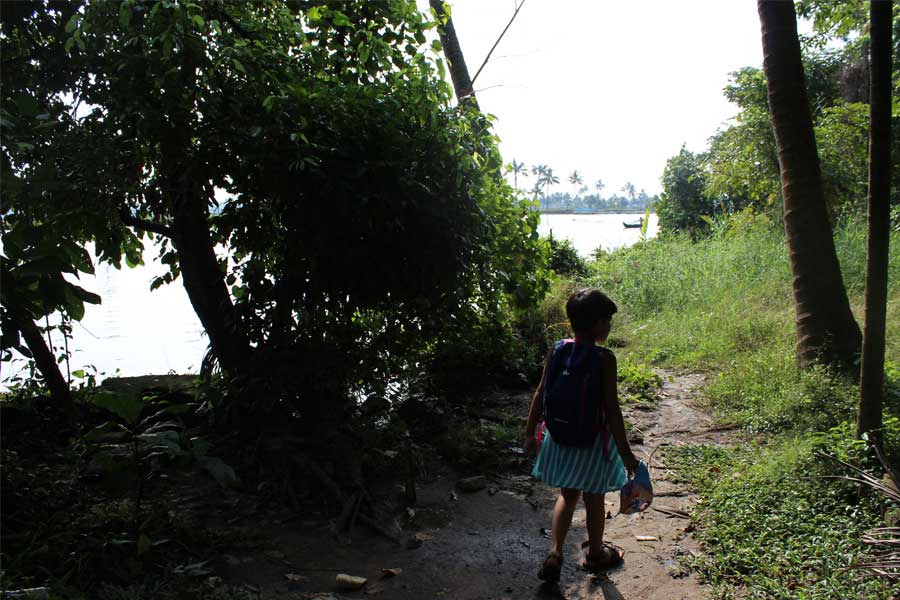
A group of youngsters were busy taking photographs of themselves hopeful of ‘likes’ on social media. After they passed, we asked a local man on a bicycle the way to the toddy shop as Antony had told us that we could find good food over there. Soon, we came across three stumps on the side of the road from where we had to walk to the toddy shop. It was a narrow path with paddy fields on both sides. It seemed like a road to eternity as there was no sign of life ahead. Charu asked us why the path is so narrow and I replied taking a cue from the biblical saying that the road to a toddy shop is meant to be narrow.
Two youngsters coming from the opposite direction were sharing the same concern and one told the other giddily that boozers who return home zigzag might end up in the water-filled paddy field. Soon the toddy shop appeared on our right all of a sudden. We could only find one customer inside the sand-floored toddy shop with a riverfront view. He was enjoying a bottle of toddy in a meditative mood. The ambience was cool and calm indeed. We could see Lord Shiva and St. George sharing the wall in parity.
Soon, a group of youngsters, (both men and women) who seemed to be co-workers came and occupied the wooden benches in the open space and started ordering bottles of sweet toddy and the entire delicacies available there—fish-head curry, rabbit, pork, beef, crab, squid, prawns and a number of sea food varieties. We ordered kappa (tapioca), appam, fish curry and kakka (shellfish) fry. While bidding adieu, I told the shop worker that we shall return someday. He gave us a classic reply with a smile: “how could you not”?

